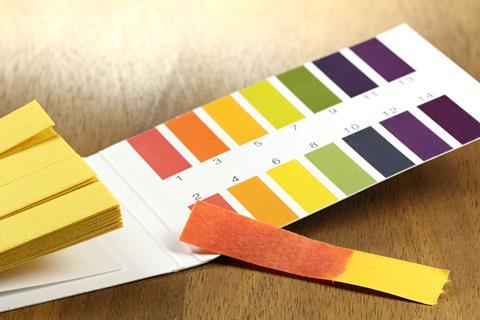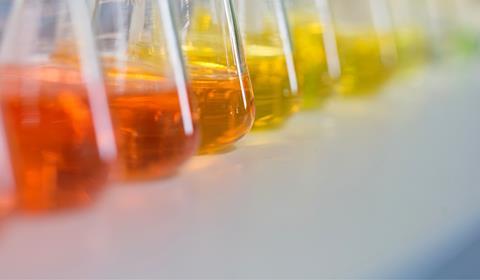Naomi Hennah suggests ideas, resources and activities for your classroom
Sodium chloride is the source of sodium in our diets, essential for the transmission of nerve impulses and the maintenance of a proper fluid balance in the body. Throughout history, humans have been using this salt to preserve meat, clean wounds and make soap.
Sodium chloride is one example of a salt. In chemistry, the term salt refers to a group of ionic compounds formed from the neutralisation reaction between an acid and a base.
The concepts of acids, bases and salts are introduced early in secondary school science, are developed and refined as students progress, and underpin many future topics. Here are some ideas to engage students, avoid misconceptions, and connect practical work to underlying concepts.
What students need to know
- Acids are hydrogen-containing substances with a sour taste that form solutions with pH values less than 7. Common examples include hydrochloric acid, sulfuric acid, citric acid and ethanoic acid (vinegar/acetic acid).
- Bases are a group of substances that neutralise acids.
- Soluble bases are called alkalis. They have a slippery, soapy feel and form solutions with pH values greater than 7. Common examples include sodium hydroxide, magnesium hydroxide, sodium hydrogen carbonate (sodium bicarbonate), sodium hypochlorite and ammonia.
- Neutralisation is a reaction between an acid and an alkali that forms a salt and water.
- Salts are odourless and have a salty taste, and many are soluble in water. Common examples include sodium chloride, potassium iodide, calcium carbonate and copper sulfate.
- The pH scale is used to measure acidity and alkalinity.
- Indicators are substances that change colour with a change in acidity/alkalinity. Litmus is a common indicator; alkaline solutions turn red litmus blue and acid solutions turn blue litmus red.
- Acids can react with some metals to form a salt and hydrogen gas.
Ideas for the classroom
Students have a wealth of experience of acids, bases and salts accumulated from both school and everyday life. It is worth starting the topic by eliciting their existing ideas by constructing a mind-map together. Be alert to miscomprehensions and aim to address these before moving on.
Using real-life examples and anecdotes in your classroom can help make ideas stick. Download a selection of acid, base and salt anecdotes (MS Word or pdf).
Using real-life examples and anecdotes in your classroom can help make ideas stick. Download a selection of acid, base and salt anecdotes from the Education in Chemistry website: rsc.li/2Oj0lQk.
One particular problem that can arise when introducing laboratory acids and alkalis is that they both look like water. Students can struggle to use chemical properties to characterise these solutions. The ‘Sage and scribe’ task can be used to demonstrate the limitations of visual description, and reinforce the need to look for the presence or absence of defined characteristics or properties. Download the student information (MS PowerPoint or pdf) and teacher notes (MS Word or pdf) for this activity.
One particular problem that can arise when introducing laboratory acids and alkalis is that they both look like water. Students can struggle to use chemical properties to characterise these solutions. The ‘Sage and scribe’ task can be used to demonstrate the limitations of visual description, and reinforce the need to look for the presence or absence of defined characteristics or properties. Download the student information and teacher notes for this activity: rsc.li/2Oj0lQk.

In this activity, the sage has to describe a simple image to two scribes. One scribe records the sage’s description, while the other tries to make a drawing from it. Can the scribes identify the image? Descriptions are subjective and can be misinterpreted, whereas identification requires an objective approach.
Link this idea to how we can positively distinguish between two solutions that look like water, specifically with the use of indicators with acids and alkalis.
Aim to introduce acids and alkalis equally rather than focus on acids alone. For homework, ask students to identify household substances that are acids and alkalis. These will be commonly found in the kitchen and bathroom. For example, vinegar and lemon juice are acids whereas baking powder and toothpaste are alkalis. Student can bring in samples and test them using the Acid or alkali? Acidic or alkaline? activity. The Colour creactions activity can then be used to introduce universal indicator and the pH scale before moving on to neutralisation.
Aim to introduce acids and alkalis equally rather than focus on acids alone. For homework, ask students to identify household substances that are acids and alkalis. These will be commonly found in the kitchen and bathroom. For example, vinegar and lemon juice are acids whereas baking powder and toothpaste are alkalis. Student can bring in samples and test them using the ‘Acid or alkali? Acidic or alkaline?’ activity (rsc.li/2PueBT7). The ‘Colour reactions’ activity can then be used to introduce universal indicator and the pH scale before moving on to neutralisation (rsc.li/2CaCriy).
It is important to consider what you want students to learn from these activities and how this can be achieved. Time needs to be split equally between hands-on activities (including watching demonstrations and videos) and the subsequent minds-on activity of discussing the underlying concepts and ideas. Students can work collaboratively to build their understanding using structured talk activities that scaffold the making of links between practical work and the underlying concepts.
Linking practical tasks to underpinning concepts
Remember that time allocated to practical work should be split equally between hands-on activities and making links between phenomena and the underlying concepts.
Encourage students to both observe and interpret by asking questions. Try repeating their answers using the correct language. For example, replace ‘made a hole’ or ‘burnt through’ with ‘corroded’.
With practice, students can manage their own practical talk within their group. Structured talk activities should have a strict time limit. Scaffolding, such as sentence stems, encourage both listening and responding to each other.
Questions
- What did you observe?
- What can you infer/work out from this?
- Why … ?
- What do you think of …?
- What are the implications for …?
- How might …?
Sentence stems
- I saw …
- I think this shows …
- This suggests that …
- I think this tells us …
- But what about … ?
- I disagree with you because …
- I don’t understand …
Common misconceptions
Students often believe that only acids are corrosive and can be identified because they eat away/burn materials. However, alkalis can also be highly corrosive, as demonstrated in the Coke cans in acid and base video.
Students often believe that only acids are corrosive and can be identified because they eat away/burn materials. However, alkalis can also be highly corrosive, as demonstrated in the ‘Coke cans in acid and base’ video (bit.ly/2C5YyXv).

Use the video as a prompt to draw out ideas of corrosion. Explain that corrosion can be defined as ‘the degradation or breakdown of a material due to a reaction with its environment’. Degradation is a change in the bulk properties of a material, which will look different, become weaker or even break apart because of chemical changes. This description encourages students to see materials at both the macroscopic (bulk) level and the submicroscopic (particle) level. For example, the sodium hydroxide solution is added to the aluminium can, which breaks apart with the release of gas (macroscopic), because the sodium hydroxide particles are reacting with the aluminium particles to form an aluminium salt and hydrogen gas (sub-microscopic).
Use the video as a prompt to draw out ideas of corrosion. Explain that corrosion can be defined as ‘the degradation or breakdown of a material due to a reaction with its environment’. Degradation is a change in the bulk properties of a material, which will look different, become weaker or even break apart because of chemical changes. This description encourages students to see materials at both the macroscopic (bulk) level and the submicroscopic (particle) level (find out more about getting your students to think about how they learn: rsc.li/2C596X0). For example, the sodium hydroxide solution is added to the aluminium can, which breaks apart with the release of gas (macroscopic), because the sodium hydroxide particles are reacting with the aluminium particles to form an aluminium salt and hydrogen gas (sub-microscopic).
Try to avoid the use of anthropomorphic descriptions such as ‘attack’ or ‘eat’ away. These terms tend to lead to ideas about chemicals ‘wanting’ or ‘needing’ to react. This will make it harder for students to develop a solid understanding of how and why chemical reaction proceed.
Formative assessment
Concept mapping is a useful tool for reinforcing how this topic links across the curriculum. The Revising acids activity has been adapted as an Assessment for Learning activity.
Concept mapping is a useful tool for reinforcing how this topic links across the curriculum. The ‘Revising acids’ activity (rsc.li/2OTINtu) has been adapted as an Assessment for Learning activity (rsc.li/2A365VQ).
Provide students with opportunities to practice both longer answer (four and six mark) and multiple-choice questions (one mark) in preparation for exams. Display the question and give the students two minutes to write their answer on mini-whiteboards. Importantly, ask them to write why they chose their answer. This provides the opportunity to identify miscomprehension and provide immediate feedback.
Progression to 14–16
In 14–16 teaching, a more sophisticated model of acidity is used, based on hydrogen and hydroxide ions. Acids release hydrogen ions (H+) in solution, and alkalis hydroxide ions (OH-).
pH is formally defined as a logarithmic measure of hydrogen ion concentration. Neutralisation is defined as the reaction of hydrogen ions and hydroxide ions to produce water. The distinction between dilute/concentrated (amount of substance) and weak/strong (degree of ionisation) is also made. Finally, there are specific apparatus and techniques that must be used and understood including rates of reaction and titration (see our guides to practical work in GCSE specifications).
pH is formally defined as a logarithmic measure of hydrogen ion concentration. Neutralisation is defined as the reaction of hydrogen ions and hydroxide ions to produce water. The distinction between dilute/concentrated (amount of substance) and weak/strong (degree of ionisation) is also made. Finally, there are specific apparatus and techniques that must be used and understood including rates of reaction and titration (see our guides to practical work in GCSE specifications: rsc.li/2pIPwbD).
In summary
- Acidic and alkaline solutions can be identified by their chemical properties.
- Enforce the particulate nature of acids, bases and salts so students move away from just referring to bulk properties and anthropomorphic descriptions such as ‘ate holes in’.
- Make explicit the link between practical work and underpinning concepts using the macroscopic and sub-microscopic representations.
- This topic underpins many future topics including synthesis and analysis of chemical substances.
Downloads
Acids, bases and salts: anecdotes
Word, Size 51.5 kbAcids, bases and salts: anecdotes
PDF, Size 43.01 kbSage and scribe: student activity
PowerPoint, Size 0.13 mbSage and scribe: student activity
PDF, Size 68.54 kbSage and scribe: teacher notes
Word, Size 0.18 mbSage and scribe: teacher notes
PDF, Size 59.88 kb










No comments yet